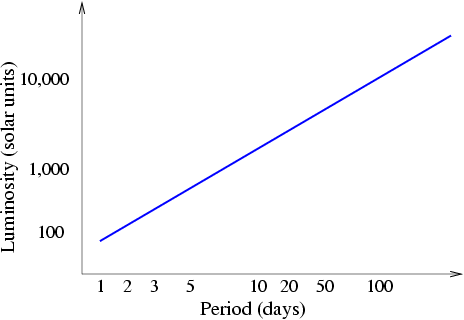 |
 |
| Harlow Shapley | Heber Curtis |
 |
 |
| Harlow Shapley | Heber Curtis |
The 1920 Shapley-Curtis Debate sheds a bright light on the commonly held cosmology of the nineteenth century – a time when astronomers thought very differently about the structure and form of the Universe than we do today. Harlow Shapley and Heber Curtis were two prominent astronomers who had spent their careers studying the Milky Way galaxy.
This agrees roughly with our current view of the Galaxy: the Milky Way has a diameter of 100,000 light-years, and the Sun lies 25,000 light-years away from the center, in the disk component.
In 1908, Harvard astronomer Henrietta Swan Leavitt had studied photographs of the Magellanic Clouds (the two galaxies closest to the Milky Way). They showed that the Magellanic Clouds were made up of clumps of individual stars, some of which were Cepheid variable stars. Cepheid variables are a type of star which changes its luminosity regularly, pulsing from faint (and cool) to bright (and hot) over a period of one to one hundred days. Repeated observations of such a star will show it waxing and waning in brightness, as shown in the light curve below.
 |
| [NMSU, N. Vogt] |
Leavitt found that images of the Cepheids in the Magellanic clouds showed a distinct pattern: the longer the period of the luminosity cycle, the brighter the star. Since all of the Cepheid stars in the Magellanic clouds lay together at the same distance from the Earth, this meant that the longer period Cepheids were intrinsically more luminous stars.
 |
| [NMSU, N. Vogt] |
The trick then became to determine the distance to one (any one!) Cepheid variable star, in order to set a zero point to this relation between intrinsic luminosity and period. With this known, the true distance to any Cepheid could be determined: measure the period of the luminosity variation, observe the apparent luminosity, and calculate the distance at which the star must lie in order for it to appear this bright. The problem was that there were no Cepheid stars near enough to the Earth that parallax could be used to determine their distances. Shapley calibrated the period-luminosity relationship for Cepheids in a rough fashion, and estimated the distance to the Magellanic Clouds. He found that the distance was less than the diameter of the Milky Way, and concluded that extragalactic nebulae were part of the Milky Way.
Shapley had additional evidence that spiral nebulae were nearby objects. Adriaan van Maanen had measured a rotational speed of 0.02 seconds of arc per year for M101; coupled with an angular size (extent) on the sky of half a degree, this meant that M101 would have had to rotate faster than the speed of light if it lay beyond the Milky Way! Furthermore, the high recessional velocities of spiral nebulae implied that they must be close enough to the Milky Way to be influenced by it.
Spiral nebulae are now know to lie far beyond the Galaxy. Maanen's measurements of proper motion for M101 were shown later to be simply incorrect, when re-evaluated by other astronomers. The high recessional velocities are now interpreted as support for an expanding universe, where all galaxies are racing away from each other as space itself expands.
Curtis was correct to claim that spiral nebulae are separate from the Milky Way. The question was settled in 1923 when Edwin Hubble, using the new Mt. Wilson 100-inch telescope, detected Cepheid variables in the great nebulae in Andromeda (M31). Using Shapley's calibration of the period-luminosity relation, Hubble concluded that M31 was at a distance of 1.2 million light-years – far beyond the outer limits of the Milky Way. As observations accumulated, it gradually became clear which fuzzy patches belonged to the Galaxy, and which were completely separate groups of stars. The spiral nebulae became known as extragalactic nebulae, then as island universes, and finally just as other galaxies.
 |
 |
| The Mount Wilson 100-inch telescope | The Andromeda Galaxy (M31), shown next to the Moon for scale. [NOAO/AURA/NSF] |